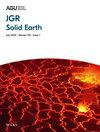Magnetofossil Contribution to Sedimentary Magnetic Records and Sediment Provenance Reconstruction: A Case From the Bengal Fan
IF 4.1
2区 地球科学
Q1 GEOCHEMISTRY & GEOPHYSICS
引用次数: 0
Abstract
Environmental magnetism is widely employed for sediment provenance study, particularly in detrital‐dominated marine and lake systems. However, magnetofossils can complicate magnetic signals for accurate reconstructions of source‐to‐sink processes, yet their impact remains underexplored. The Bengal Fan, the largest submarine fan in the world, provides an ideal setting for studying sediment transport for its diverse sediment sources and transport pathways. Here, we combine magnetic and electron microscope analyses on a large set of surface sediments from the central and lower Bengal Fan to characterize magnetofossil contributions to magnetic properties. Results demonstrate widespread magnetofossil occurrence. Quantitative unmixing of isothermal remanent acquisition curves and first‐order reversal curve‐principal component analysis, assisted with direct transmission electron microscopic imaging of magnetofossils reveal that the southernmost region contains the highest magnetofossil contribution. Total organic carbon influences the magnetofossil abundance, while the magnetofossil morphology compositions are likely modulated by redox conditions impacting the diversity of magnetotactic bacteria species. Fuzzy磁化石对沉积磁记录和沉积物物源重建的贡献:以孟加拉扇为例
环境磁学在沉积物物源研究中得到了广泛的应用,特别是在碎屑为主的海洋和湖泊体系中。然而,磁化石可以使磁信号复杂化,以精确地重建源-汇过程,但它们的影响仍未得到充分探索。孟加拉扇是世界上最大的海底扇,其沉积物来源和输送途径多样,为研究沉积物输送提供了理想的环境。在这里,我们结合了对孟加拉扇中下部大量地表沉积物的磁性和电子显微镜分析,以表征磁化石对磁性的贡献。结果表明磁化石分布广泛。等温剩余物采集曲线和一阶反转曲线的定量分析-主成分分析,结合磁化石的直接透射电镜成像,揭示了最南端地区磁化石的贡献最大。总有机碳影响着磁化石的丰度,而磁化石的形态组成可能受到氧化还原条件对趋磁细菌种类多样性的影响。模糊c均值聚类分析确定了四个沉积物簇。集群1来自印度半岛。集群2代表喜马拉雅-缅甸-印度混合,由活动通道输送,并向下游细化。星系团4和星系团3的南部表现出与高磁化石贡献有关的异常磁粒度趋势。磁化石的存在改变了碎屑磁记录,显示了磁化石磁化强度与体磁粒度参数的高度相关性,从而使物源解释复杂化。我们展示了结合使用岩石磁学和电子显微镜来量化磁化石的贡献,以实现强大的磁解释,特别是在高碎屑输入区域,磁化石经常被忽视。
本文章由计算机程序翻译,如有差异,请以英文原文为准。
求助全文
约1分钟内获得全文
求助全文
来源期刊

Journal of Geophysical Research: Solid Earth
Earth and Planetary Sciences-Geophysics
CiteScore
7.50
自引率
15.40%
发文量
559
期刊介绍:
The Journal of Geophysical Research: Solid Earth serves as the premier publication for the breadth of solid Earth geophysics including (in alphabetical order): electromagnetic methods; exploration geophysics; geodesy and gravity; geodynamics, rheology, and plate kinematics; geomagnetism and paleomagnetism; hydrogeophysics; Instruments, techniques, and models; solid Earth interactions with the cryosphere, atmosphere, oceans, and climate; marine geology and geophysics; natural and anthropogenic hazards; near surface geophysics; petrology, geochemistry, and mineralogy; planet Earth physics and chemistry; rock mechanics and deformation; seismology; tectonophysics; and volcanology.
JGR: Solid Earth has long distinguished itself as the venue for publication of Research Articles backed solidly by data and as well as presenting theoretical and numerical developments with broad applications. Research Articles published in JGR: Solid Earth have had long-term impacts in their fields.
JGR: Solid Earth provides a venue for special issues and special themes based on conferences, workshops, and community initiatives. JGR: Solid Earth also publishes Commentaries on research and emerging trends in the field; these are commissioned by the editors, and suggestion are welcome.
 求助内容:
求助内容: 应助结果提醒方式:
应助结果提醒方式:


